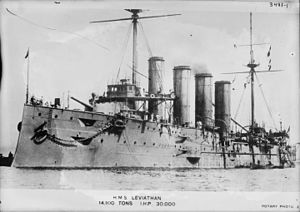 Leviathan at anchor
| |
| History | |
|---|---|
| Name | Leviathan |
| Namesake | Leviathan |
| Builder | John Brown & Company, Clydebank |
| Laid down | 30 November 1899 |
| Launched | 3 July 1901 |
| Completed | 16 June 1903 |
| Fate | Sold for scrap, 3 March 1920 |
| General characteristics | |
| Class and type | Drake-class armoured cruiser |
| Displacement | 14,150 long tons (14,380 t) (normal) |
| Length | 533 ft 6 in (162.6 m) (o/a) |
| Beam | 71 ft 4 in (21.7 m) |
| Draught | 26 ft (7.9 m) |
| Installed power |
|
| Propulsion |
|
| Speed | 23 knots (43 km/h; 26 mph) |
| Complement | 900 |
| Armament |
|
| Armour | |
HMS Leviathan was one of four Drake-class armoured cruisers built for the Royal Navy around 1900. She was assigned to the China Station upon completion and then served in the Mediterranean Fleet in 1905–06. She was assigned to the 7th Cruiser Squadron in 1907 before she was briefly reduced to reserve. Leviathan was recommissioned in 1909 for service with the 4th Cruiser Squadron before she was placed in reserve in 1913.
Recommissioned in mid-1914, she was assigned to the 6th Cruiser Squadron of the Grand Fleet at the beginning of World War I. She spent most of the rest of the year searching for German commerce raiders and escorting convoys before she became flagship of the 1st Cruiser Squadron. In early 1915, she was reassigned to the 6th Cruiser Squadron before she became flagship of the North America and West Indies Station, based at the Royal Naval Dockyard in the Imperial fortress colony of Bermuda, in March. Leviathan retained that position for the next three years until she was relieved as flagship in early 1918 and began escorting convoys from North America to Britain. She was placed in reserve in 1919 and sold for scrap in early 1920.
Cite error: There are <ref group=Note> tags on this page, but the references will not show without a {{reflist|group=Note}} template (see the help page).
